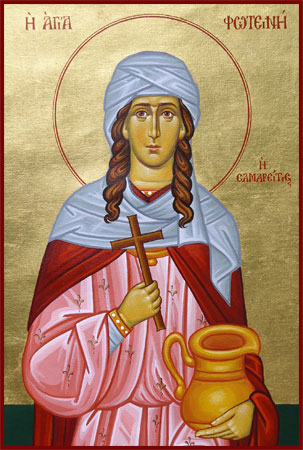I recently discovered on several Orthodox sites, that the Eastern Church honors the Woman at the Well as a saint and martyr. Her name is St. Phontine of Samaria, and Phontine means, "the Enlightened One". This saint is appropriate as one who introduces us to the last stage of Affective Prayer into the movement of true contemplation.
She apparently converted her sisters and her sons, SS. Anatole, Photo, Photis, Paraskeve, Kyriake, Photinos, and Joses. According to tradition, they all traveled to Carthage in order to evangelize the people there and were martyred under Nero.
Her feast day is near-February 26th in one tradition and March 20th in another, that is the Greek and Slavic traditions. She is also honored on the Fifth Sunday after Easter, the Sunday of the Samaritan Woman, with the readings referring to Christ as the Living Water. Among the Slavic people, she is called Svetlana, a popular Russian name even today.
St. Photine was a feisty saint and is recorded as having spit in the face of Nero after her first tortures before being put to death.
She could have been as old as 66 when she was martyred.
As her name means "the Enlightened One", Photine is a perfect example of a saint in the Illuminative State, the state which follows the time of Affective Prayer.
The Illuminative State will be discussed further in the series on perfection, but here I want to concentrate on the ending of the time of Affective Prayer and the moving into true Contemplative Prayer.
Here is Garrigou-Lagrange again:
...we must allow ourselves to be led by the path which our Lord has chosen for us. There is, to be sure, the common and indispensable way, that of humility and conformity to the divine will; hence we must all pray as the publican did. But on this common road, one part is shaded, the other has nothing to protect it from the burning rays of the sun; one section is flat, followed by long, steep hills that lead to high plateaus where we may enjoy a marvelous view. The good Shepherd leads His sheep as He judges best. Some He guides by the parables, others by the way of reasoning; to others He gives, in the obscurity of faith, simple and penetrating intuition, great views of the whole, which are the distinctive characteristic of wisdom. He leaves certain souls for a rather long time in difficulties in order to inure them to the struggle. For several years St. Teresa herself had to make use of a book in order to meditate, and the time seemed very long to her. Our Lord raises the Marys rather than the Marthas to contemplation, but the former find therein intimate sufferings unknown to the latter; and if the latter are faithful, they will reach the living waters and will slake their thirst according to their desire.
We must, therefore, allow ourselves to be led by the road which the Lord has chosen for us. If aridity is prolonged, we should know that it does not spring from lukewarmness, provided that we have no taste for the things of the world but rather concern for our spiritual progress. Aridity, on the contrary, is very useful, like fire that must dry out the wood before setting it ablaze. Aridity is needed precisely to dry up our too lively, too impetuous, exuberant, and tumultuous sensibility, so that finally the sensible appetites may be quieted and become submissive to the spirit; so that, above these passing emotions, there may grow in us the strong and pure love of charity, which has its seat in the elevated part of the soul.
At this stage, the Dark Night finally ends and one is taken into the Illuminative State. I can honestly say that I have only met a handful of people in this state. And this means that very few people have allowed themselves to go through purgation to the last two stages of the life of perfection.
Then if we are faithful, as St. Thomas teaches,(9) we shall gradually begin to contemplate God in the mirror of sensible things, or in that of the parables. Our soul will rise from one of these parables to the thought of infinite mercy, by a straight movement, like that of a lark soaring directly from earth toward heaven.
At other times we shall contemplate God in the mirror of the mysteries of salvation, aiding ourselves, for example, by recalling the mysteries of the Rosary. By a spiral (oblique) movement analogous to the flight of the swallow, we shall rise from the joyful to the sorrowful mysteries, and to those which announce the life of heaven.
Finally, on certain days we shall contemplate God in Himself, holding fast in the obscurity of faith to the thought of His infinite goodness which communicates to us all the blessings we receive. By a circular movement similar to that of the eagle high in the air, we shall repeatedly come back to this thought of the divine goodness.
And, whereas the egoist always thinks of himself and refers everything to himself, we shall begin to think always of God dwelling in us, and to refer everything to Him. Then, even when the most unforeseen and painful events occur, we shall think of the glory of God and of the manifestation of His goodness, and we shall glimpse from afar the supreme Good toward which everything, trials as well as joys, should converge. This is truly the life of prayer, which allows us to see all things in God; it is the normal prelude of eternal life.
- O Almighty Saviour, Who did pour forth water for the Hebrews from a solid rock:
- You did come to the Land of Samaria, and addressed a woman,
- whom You did attract to faith in You,
- and she has now attained life in the heavens everlastingly.


